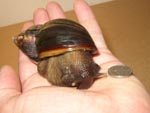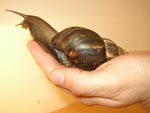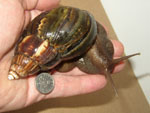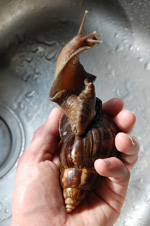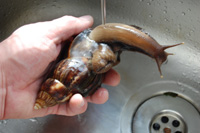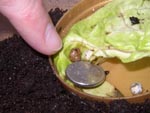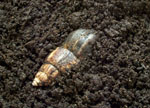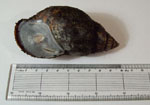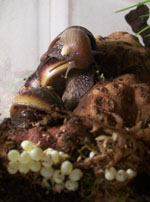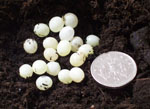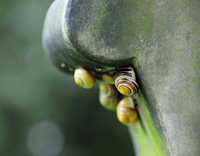Giant African Land Snails
Achatina fulica
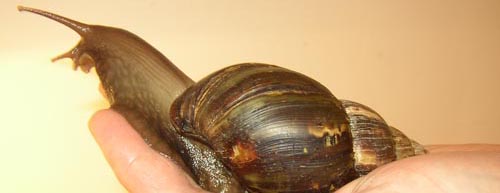
East African Giant African Land Snail.
The latin name is Achatina fulica.
Note the unusual green markings on this Giant Snail Shell.
In the summer of 2007 I was given an adult Giant African Land Snail as a pet.
I named him "Arnie" after Bodybuilder and action film star Arnold Schwarzenegger.
The Giant Snail's Shell is now over 4.25 inches long and he weighs an impressive
175 grams (that's just over 6 ounces).
"He" promptly laid a clutch of around 60 eggs. Only two of the Snail Eggs hatched
and I named the Baby Snails Homer and Marge.
A month later came the second batch of 70ish Snail Eggs - most of which
hatched. A third clutch was laid about one month after that.
| Photos of Giant African Land Snails |
Photos of Arnie the Giant African Land Snail.
Bathtime for Arnie the Giant African Land Snail
Baby Giant African Land Snails
| How to Care for Giant African Land Snails |
You can keep your Giant African Land Snails in a plastic or glass vivarium or
terrarium (tank). I keep mine in an Exo Terra 18" x 18" x 18" (45cm x 45cm x
45cm) Terrarium which has a mesh roof and front opening glass doors.
These are perfect for snails!
Giant Snails like a 2 inches or deeper layer of damp compost to burrow into.
The compost can be peat based, an alternative could be cocoa fibre.
Snails need a luke warm spray of water once or twice a day. A small plant
mister is ideal for this. Terrarium humidity should be around 60 - 70%.
I keep the baby snails in ventilated sandwich boxes.
Giant African Land Snails are a tropical species and like to be kept at
temperatures between 20 - 26 degrees C. The Snails are best kept out of
direct sunlight and in winter if kept in a cool room should be provided with
a heat mat attached to the side of the terrarium/tank - available from a
pet shop.
Create a more interesting environment for your pet snails by adding pieces of
interesting driftwood and cork bark for them to climb over and hide under. You
can also decorate the tank with sphagnum moss and artificial plants. Avoid hard
objects as shells can crack if snails fall from the sides or top of the tank.
| Feeding Giant African Land Snails - Food/Diet |
Arnie the Giant African Land Snail and the young Snails seem to eat
almost any kind of fruit and vegetable matter. Favourite foods are cucumber and
lettuce, peppers, green beans, tomatoes and sweetcorn. Snails also eat brown
bread and even cat biscuits. Do not feed pasta to your snails as it will swell
up inside them and damage or even kill them.
Giant African Land Snails are known to eat up to 500 different plant species.
Giant Land Snails need a supply of calcium for the growth of their shells.
Cuttlefish bone is an ideal source of this mineral.
| Giant African Land Snails - Hibernation / Estivation |
Giant African Land Snails will go into hibernation if temperatures get too low.
Here are some photographs of Arnie hibernating (sleeping). Note the membrane
which has formed over the aperture to his shell. The membrane (epiphragm) is
made of dried mucus and helps keep the snail moist. In warm weather Giant
African Land Snails will go into summer hibernation (estivation) if they get too
dry. You should spray your snails daily with luke warm water to prevent this from
happening. Arnie the Giant African Snail hibernated for several weeks from late
autumn 2007 to early spring 2008. As soon as he woke up he became quite active
and resumed eating as normal - and he is still growing!
| Breeding Giant African Land Snails, Their Life Cycle |
Giant African Land Snails Mating
Giant African Land Snails are hermaphrodites i.e. they have both male and
female reproductive organs. You need two snails to breed and if two snails of
different sizes mate, the largest of the two normally plays the part of the female
and carries the eggs. Once mated Giant African Land Snails have the
capacity to have produce clutches of eggs in instalments. Giant Snails can lay
clutches of eggs several months apart giving the young snails a greater chance
of survival.
Sexual maturity in Giant African Land Snails takes 6 to 16 months depending
on environmental conditions and availability of calcium. At 6 months old GALS
are around 35mm long.
In the photo of the Giant African Land Snails mating above you can see the
white male reproductive organ on the snail's neck. At the bottom of the photo
is a freshly laid clutch of snail eggs which are about 5mm long.
Giant African Land Snails are said to be able to lay up to 1,200 eggs in a year!
Giant Snail Eggs take 2 - 6 weeks to hatch. They should be kept in damp
compost and at a temperature of around 20 - 25 C.
Giant African Land Snails normally live for 5 - 6 years but they can live up to
9 years old.
| Handling Giant African Land Snails |
Giant African Land Snails enjoy being handled but should be treated with care
as their shells are quite fragile especially when young. Spray your hand with
water to make it more comfortable for the snail. If the snail is on the side of the
tank, spray water on and around the snail, ease your fingers underneath it and
lift it off gently.
Don't try to pull the snail off by its shell - you could pull it out of its shell!
Don't pick up the snail by the front growing part of the shell which is very
delicate and easily damaged.
You can clean your snail in luke warm water using a fine paint brush but be
careful not to get water into its breathing hole just inside its shell.
| Interesting Giant African Land Snail Facts |
Heliciculture is the farming or raising of Snails.
Malacology is the study of Molluscs / invertebrates (animals without backbones).
Conchology is the study of mollusc Shells (Molusck US spelling).
Giant African Land Snails is often abbreviated to GALS.
| Photos/Pictures of Giant African Land Snails & Others |
NEW! Steve Greaves
Snail Postcard on Ebay
White Lipped Banded Snail
(Cepaea hortensis)
More Snail Photos Coming Soon!
Legal note for the US.
The US Department of Agriculture (USDA) bans the importation of, and it is
illegal to possess, live Giant African Snails.
Giant African
Land Snails
Books & Toys
Gift Ideas:
How to care for your
Giant African Land Snail
Book
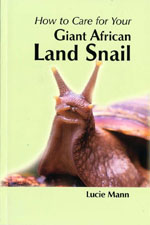
NEW! Steve Greaves
Snail Postcard on Ebay
White Lipped Banded Snail
(Cepaea hortensis)
Gary the Snail
Spongebob Squarepants
Childrens' Soft Toy
Clockwork Snail Toy
Gary the Snail
Beanie Keyring/Keychain
The Snail
Art Print by Matisse
Wooden Pull-along
Snail Toy
Childrens' Sit-on
Rocking Snail
Wooden 1-10
Counting Snail
Number Puzzle
Bergundy Snail
Jigsaw Puzzle
Teddy Bear with
Snail T-shirt
Glass Worktop Saver
with Snail Design
Snail Bookends
Reptile Tank
Ideal for Giant Snails!
A Branch Climbing
Frame for your Snails
